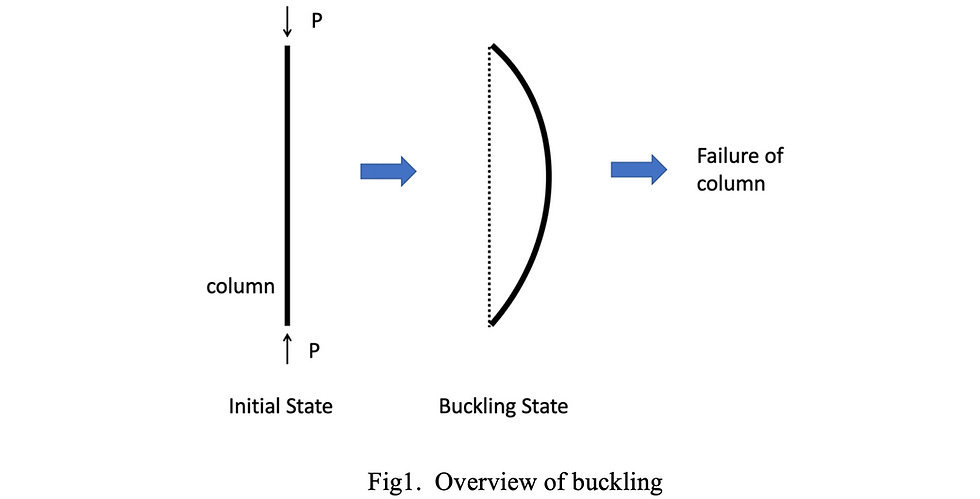សង្ខេបសារណាបញ្ចប់ថ្នាក់មធ្យមសិក្សាបច្ចេកទេស
- PEN I Uoy

- Aug 18, 2019
- 4 min read
នេះគឺជាអត្ថបទសង្ខេបនៃសារណាបញ្ចប់ថ្នាក់មធ្យមសិក្សាបច្ចេកទេសរបស់ខ្ញុំ។ ដោយហេតុថាចំណេះដឹងរបស់ខ្ញុំក្នុងវិស័យវិស្វកម្មសំណង់មានតិចតួចស្តួចស្តើង ខ្ញុំមិនទាន់អាចបកប្រែជាភាសាជាតិបានទេ។ អត្ថបទខាងក្រោមជាភាសាអង់គ្លេស ហើយនៅចុងទំព័រលោកអ្នកអាចទាញយកឯកសារនេះpdfបាន។ សង្ឃឹមថាវាមានប្រយោជន៍សម្រាប់អ្នកសិក្សាទូទៅជាពិសេសសិក្ខាកាមក្នុងវិស័យវិស្មកម្មសំណង់។
"Sustainability Evaluation of Reinforced Concrete Members"
1. Introduction
In recent years, in construction field there is a tendency of change in evaluation of structure from the idea of focusing on “safety” to sustainability idea which comprehensively evaluates the balance of “social aspect”, “economical aspect” and “environmental aspect”. For example, the fib (International Federation for Structural Concrete) and ACI (American Concrete Institute) have proposed the importance of introduction of sustainability in required performance of each design standard.
The objective of this research is to do a sustainability evaluation on reinforced concrete’s members (RC members). In detail, changes of (1) diameter of rebars, (2) compressive strength of concrete, (3) yield strength of rebars, (4) effective height and (5) production method of steel were made to a basic designed beam, and influences of these causes on “strength”, “cost” and “CO2 emission amount” were found by numeric calculation and researching on various documents.
2. Sustainability Design of RC members
2.1 Elements of RC member
Basic elements of RC beam for numeric calculation is shown in Figure.1.

Figure.1: Cross section plan of RC beam
2.2 Numeric Calculation
A. Conditions of Calculation
The representing elements for sustainability’s three aspects are: “strength (for simplification purpose, only design bending strength was used)” for social aspect, “production cost” for economical aspect, and “CO2 emission amount” for environmental aspect.
Furthermore, the ranges of change for each method are : D8 to D29 for diameter of rebars, 18 N/mm2 to 30N/mm2 for compressive strength of concrete, SD295 to SD490 for yield strength of rebars,blast furnace and electric furnace for steel’s production methods.
B. Calculation Method of Strength

where,:area of rebars,:yield strength of rebar,:effective height,: balanced steel ratio,:compressive strength of concrete.
By the way,since flexural failure which consists of toughness must precede, design bending strength was set to be smaller than design shear strength.
C. Calculation Method of Cost
Cost = cost of rebars + cost of stirrups + cost of concrete (2)
where,cost of steels = M ×L× Cs× N (2.1)
cost of concrete = (Cv − Rs )×Cc (2.2)
and, M[kg/m] : unit mass of steel, L[m] : length of steel, Cs[¥/kg] : unit price of steel, N : number of steel,Cv[m3] : volume of concrete, Rs[m3] : volume of steel, Cc[¥/m3] : unit price of concrete.
D. Calculation Method of CO2 Emission
CO2 = CO2 by rebars + CO2 by stirrups + CO2 by concrete (3)
where,CO2 by steels = M × L × COs × N (3.1)
CO2 by concrete = (Cv − Rs )×C×COc (3.2)
and,M, L, N are the same as shown in equation (2.1),COs[kgCO2/kg] : unit CO2 emission of steel, Cv, RS are the same as shown in equation (2.2),C[kg/m3] : unit mass of cement,COc[kgCO2/kg] : unit CO2 emission amount of cement.
3. Calculation’s Results and Discussions
3.1 Influence of Rebars
Figure.2 shows relationship of the three elements when diameter of rebars were changed. When diameter of rebars became bigger, increasing tendency of the three elements can be seen. While, strength and cost increased with high magnification, increasing rate of CO2 emission amount was comparatively small.

Figure.2: Relationship between the three elements
3.2 Influence of Concrete’s Compressive Strength
Figure.3 shows relationship of the three elements when compressive strength of concrete was changed. When compressive strength of concrete became bigger, increasing tendency of the three elements can be seen. While, strength and cost increased with almost the same magnifications, increasing rate of CO2 emission amount was comparatively big.

Figure.3: Relationship between the three elements
3.3 Influence of Rebar’s Yield Strength
Figure.4 shows relationship of the strength and cost when yield strength of rebars were changed. When yield strength of rebars became bigger, increasing tendency of the two elements can be seen. And, strength increased in larger magnification than cost did. Though, due to lack of documents related to influence of rebar’s yield strength on CO2 emission, in this case CO2 emission was unknown.

Figure.4: Strength, cost-rebar's yield strength
3.4 Influence of Depth(Effective Height)
Figure.5 shows relationship between strength and effective height. When effective height got bigger, increasing tendency of strength can be seen. Besides, from equations (2.1), (2.2), (3.1) and (3.2) cost and CO2 emission amount is irrelative with effective height.

Figure.5:Strength-effective height relationship
3.5 Influence of Steel’s Production Methods
Table.1 shows the different amounts of CO2 emission by production methods of steel. By changing from blast furnace to electric furnace, amount of CO2 emission can be reduced. On the other hand, from equation (1), strength is irrelative with steel’s production methods. Due to lack of documents, in this case cost was unknown.
Table.1:CO2 emission by steel's production methods

4. Conclusions
(1) The relationship between the three elements of sustainability which are strength, cost and amount of CO2 emission changes according to each cause.
(2) Preparation of inventory data related to relationship between yield of rebar with amount of CO2 emission and price of steel made by blast furnace or electric furnace is necessary in further research.
References
1) 堺孝司,横田弘:コンクリート構造物のサステイナビリティ設計「地球環境と人間社会の不確実性への挑戦」,技報堂出版,2016
2) Shibata T, Kata K, Kasuga A, Sakai K : Sustainability evaluation of butterfly web bridge, Structural Concrete, 2017;1-18




Comments